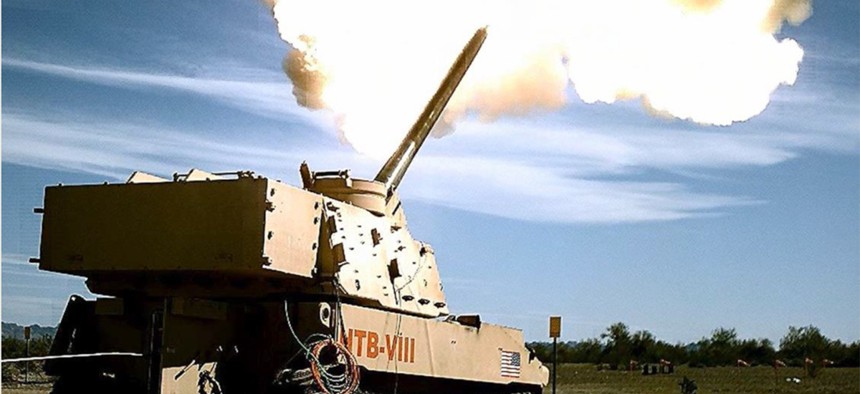
Extended Range Cannon Artillery, or ERCA, from the US Army. US ARMY / Edward Lopez
US Army’s Not Stupid for Wanting Long-Range Fires — But More Analysis Needed, Hyten Says
“You want each service to bring those long-range fires,” the Joint Chiefs’ vice chairman said.
SEATTLE, Washington — It’s more than appropriate to weigh a long-range fires capability for the U.S. Army, even if more analysis ultimately shows that the costs would outweigh the benefits, the Joint Chiefs’ vice chairman said Monday.
Several days ago, the leader of Air Force Global Strike Command disparaged Army efforts to develop various long-range weapons. On Monday, Gen. John Hyten spoke to Defense One and said the Pentagon’s new joint warfighting concept stresses that future battles will be fought by small, expeditionary units coming together at times to hit some targets and then dispersing. And every service will need to be able to defeat an enemy’s own long-range missiles.
"You might aggregate Navy and Army; you might aggregate Air Force and Army, but if someone shows up to the battle and they don’t have long-range fires and the adversary does, you can’t effectively operate in that theatre,” he said. “This means you want each service to bring those long-range fires; so, the joint warfighting concept succeeds if all of the force can apply fires wherever they happen to be, wherever the target is, whatever the lines of conflict, that is the joint warfighting concept.”
Last week, Air Force Gen. Timothy Ray said on a Mitchell Institute podcast that long-range strike capability properly resided with his own service.
“Why in the world would we entertain a brutally expensive idea when we don’t, as the [Defense] Department, have the money to go do that,” said the Air Force Global Strike Command leader. “I just think it’s a stupid idea to go and invest that kind of money that recreates something that the [Air Force] has mastered and that we’re doing already right now. Why in the world would you try that? I try to make sure that my language isn’t a little more colorful than it is, but give me a break.”
Back in 2017, the Army selected long-range fires as one of its key modernization priorities. Since then, it’s been developing these in the form of a hypersonic weapon, which the Army is co-developing with the Navy, and a large gun called the XM1299 cannon that can fire munitions 65 kilometers, compared to about 18 kilometers for a howitzer. The Army is experimenting with them ahead of first planned deployments in 2023.
In March, Joint Chiefs Chairman Gen. Mark Milley said that the joint warfighting concept should come together this year. The concept will further drive the development of doctrine and requirements that the services will take to build and train for a new era of highly-interconnected warfare, a broad vision that the Pentagon calls Joint All-Domain Command and Control, or JADC2. “Concepts are used to develop doctrine, to develop organizations that will employ the doctrine and to do force development, force design for weapons systems that you will need to execute the doctrine,” said Milley.
Hyten also stressed that there’s a big difference between having a concept and having a concrete plan, schedule, or budget. The concept lets you get to those later steps. Army long-range fires play a role in the concept, but experimentation, research, and analysis will later show if it's feasible economically. The concept, he said, “is aspiration, not cost-informed. You don’t want it to be."
NEXT STORY: US Army Wants Face Recognition at Base Gates




